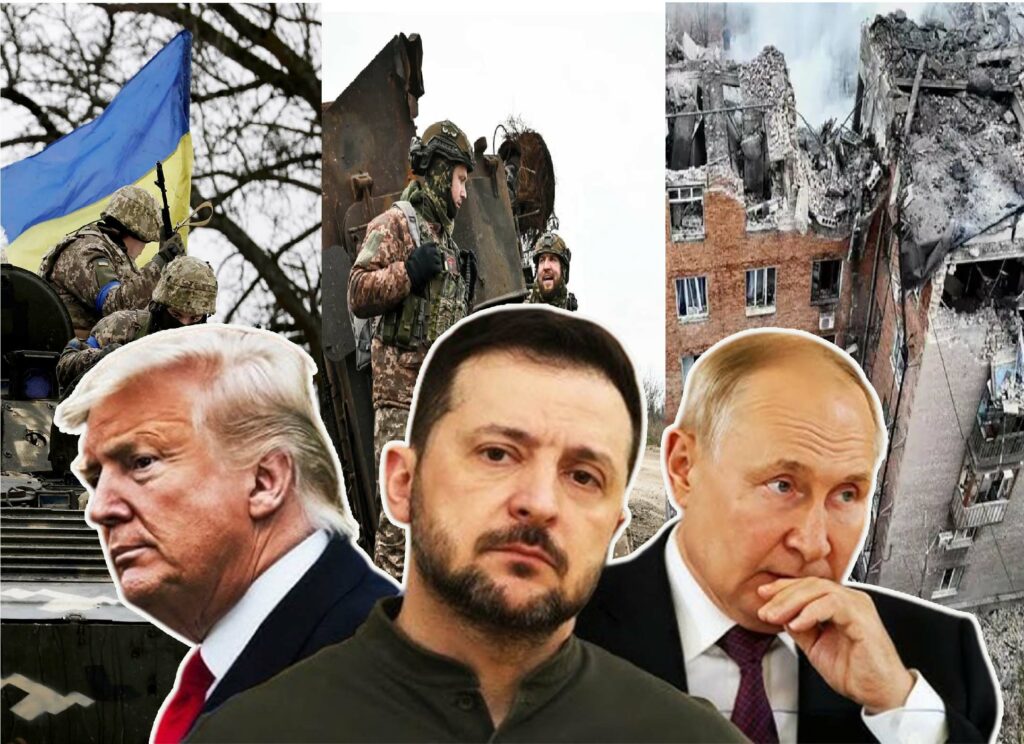
- With the war entering its third year, hope for peace has been revived, particularly with President Trump having regained power and urging negotiations.
- Prime Minister Narendra Modi was in a singular position—one of the only few global leaders who addressed both President Putin and President Zelensky.
- Trump contended that Ukraine should negotiate peace with Russia and even proposed that Ukraine give up some territories for the sake of peace.
- With the U.S. slowly turning away from Ukraine and negotiating with Russia, Ukraine becomes more isolated.
On 24 February 2022, Russia launched a special military operation against Ukraine. The basis for the operation was principally that Russia did not want to see Ukraine enter NATO and was always expanding NATO towards the east, which in Moscow’s opinion presented an instant danger to Russia’s security. The issue traces back to the United States and Soviet Union agreements in 1991 when Russia argued that NATO had assured that it would not expand to the east.
With the war approaching its third anniversary, it has experienced several highs and lows. While Russia has managed to assert its strategic security to some extent, the war has resulted in huge military, economic, and political losses for both Russia and Ukraine. Most believed at first that Russia’s attack would simply overwhelm Ukraine, especially with its huge assault on Kyiv in the first week. However, because of logistical inadequacies and strong Ukrainian resistance, Russia did not succeed in winning a quick victory.
Reasons for the Prolonged War
One of the key reasons Ukraine remained resilient was its preparation for the 2014 war and the Minsk Agreements. The agreements gave Ukraine valuable time to develop its defence and military capabilities. This came later as confirmation from former German Chancellor Angela Merkel, who admitted that the Minsk Agreements were merely a tactic to provide Ukraine with time to prepare for a future conflict with Russia.
By September 2022, Russia had officially annexed the four Ukrainian regions of Luhansk, Donetsk, Kherson, and Zaporizhzhia. The war quickly, though, came to a stalemate, with neither side advancing much in terms of land. Ukraine’s preparedness for modern warfare was central to halting Russia from achieving its objectives.
A major shift was witnessed when Russia elevated General Sergei Surovikin to its military commander. With him, Russia shifted its strategy by targeting Ukraine’s critical infrastructure, such as energy grids and power plants, with widespread missile and drone attacks. This brought immense hardship to Ukraine, which had to divert resources from frontline fighting.
In 2023, Russia acquired two significant chunks of land by taking over Soledar and Bakhmut. The battle for Bakhmut, in particular, turned into a protracted war of attrition in which Ukraine lost a huge number of soldiers and equipment. Those losses caused a substantial turnover in the upper echelons of the leadership of Ukraine, where Commander-in-Chief Valerii Zaluzhnyi was stripped of his position and General Oleksandr Syrskyi assumed command and Rustem Umerov was named new defence minister. Meanwhile, back in Russia, President Putin dismissed his seasoned defence minister, Sergei Shoigu, and replaced him with Andrei Belousov.
Despite all its endeavours, Ukraine could not sustain the war due to manpower shortages and logistical issues. In a historic first, Ukraine penetrated deeper into Russian territory, targeting regions such as Belgorod and Kursk. This further increased Russian attacks on Ukraine. One of the turning points of the war was the United States’ approval of allowing Ukraine to attack Russian land with ATACMS missiles. This was a turning point, as the war had entered long-range strikes beyond the classical battlefield.
India’s Balancing Act
Right from the beginning of the war, India has remained a strong voice of peace. As the rest of the world sided, India went the way of diplomacy and dialogue, demanding an immediate ceasefire. It was not an easy stand to take, particularly with India’s close military relationship with Russia. Over 60% of India’s defence hardware is Russian, and the war could be a challenge to the military logistics of India itself. Prime Minister Narendra Modi was in a singular position—one of the only few global leaders who addressed both President Putin and President Zelensky. His now-famous lines at the 2022 SCO Summit in Samarkand, where he said to Putin, “This is not an era of war,” were a turning point, affirming India’s position as a country that values peace over war.
However, India was severely criticized by Western countries, especially for purchasing Russian oil. Despite the pressure, India did not give up. Rather, it highlighted the West’s double standards—while European countries continued to purchase Russian energy, they demanded that India desist. India merely did what was in its people’s interest, providing a continuous supply of cheap energy while condemning the hypocrisy of its critics.
With the war entering its third year, hope for peace has been revived, particularly with President Trump having regained power and urging negotiations. If a solution is found, India will gain—both strategically and in international trade and stability. But above all, India’s unwavering commitment to peace might at last yield fruit, demonstrating that diplomacy and pragmatism can, at times, do more than war.
Impact of Trump 2.0
The war even acquired a political undertone with the American presidential elections. With Donald Trump’s return to power, American policy towards Ukraine underwent a drastic shift. Throughout his presidential campaign, Trump ever mentioned that he wished the war to be ended immediately via negotiations. Trump contended that Ukraine should negotiate peace with Russia and even proposed that Ukraine give up some territories for the sake of peace. Ukrainian President Volodymyr Zelensky strongly rejected such negotiations based on constitutional amendments banning territorial concessions.
Trump’s government has already named a special envoy, retired General Keith Kellogg, to help negotiate. Trump also indicated that the U.S. should not keep funding Ukraine forever, stressing that American intervention in the war was a strategic error. He demanded that the U.S. learn to live with Russia and respect its sovereignty.
The Riyadh Summit was a turning point in U.S.-Russia relations, with both countries holding direct talks after years of tension. Although the summit was mainly about general U.S.-Russia relations, Trump indicated that he wanted to include both sides in peace negotiations. He was against the inclusion of NATO and the European Union in the talks, a move that has further made diplomacy more difficult.
Adding fuel to the controversy, Trump called Zelensky a “dictator,” pointing to his repression of political opposition, prohibition of pro-Russian Orthodox churches, and media centralization in state hands. These remarks ignited widespread controversy, particularly since Zelensky’s leadership style has been increasingly criticized.
Peace on the Horizon?
Trump also presented economic terms for sustained American support. Trump suggested that in return for the billions of dollars provided to Ukraine, America would receive access to Ukraine’s huge critical mineral reserves. Ukraine, which holds enormous reserves of rare earth minerals, has been reluctant to make such an offer. Zelensky is adamant that any accord must include concrete security assurances, which Trump has not yet made.
Another significant concern is the issue of U.S. financial assistance to Ukraine. Although Trump says that Ukraine has received more than $300-500 billion, Zelensky maintains that a mere $100 billion has been provided as grants, not loans. This issue of aid has further complicated U.S.-Ukraine relations.
With the U.S. slowly turning away from Ukraine and negotiating with Russia, Ukraine becomes more isolated. The war that could have been over much earlier through negotiations is now at a turning point. But Zelensky refuses to give in, and so the road to peace remains uncertain.
References:
- https://www.indiatoday.in/world/story/ukraine-russia-war-volodymyr-zelenskyy-vladimir-putin-us-president-donald-trump-european-union-dramatic-policy-shift-2684434-2025-02-24
- https://www.thehindu.com/news/international/trump-says-us-wants-return-of-ukraine-aid-money/article69253971.ece/amp/
- https://www.ndtv.com/opinion/has-trump-abandoned-ukraine-in-favour-of-russia-7774931/amp/1
- https://indianexpress.com/article/opinion/columns/three-years-of-the-ukraine-russia-conflict-lessons-for-india-9852671/
- https://indianexpress.com/article/india/two-parties-to-parties-concerned-delhi-shift-on-ukraine-peace-process-9849430/
Aayush Pal is a freelance writer on contemporary geopolitical developments. The views expressed in his work are entirely his own.
